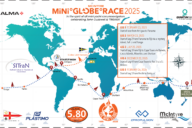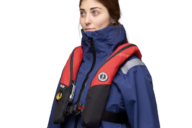The signal lamp aboard the guided-missile destroyer USS Stout flashed fast light bursts to the USS Monterey, located pierside 250 feet away. Aboard the Monterey, a guided-missile cruiser, its own signal lamp used a mounted GoPro camera to receive the incoming Morse code—which then was converted into text appearing on an accompanying handheld device.
Peering at the device connected to the Monterey’s signal lamp, Scott Lowery chuckled as one word popped up on the screen: “random.”
“I asked them to text me something random, so they signaled the word ‘random,’ ” said Lowery, an engineer at Naval Surface Warfare Center (NSWC) Panama City, Florida. “Simple, but it shows the system is working.”
Lowery recently was at Naval Station Norfolk, Virginia, conducting a demonstration of the Flashing Light to Text Converter (FLTC)—a ship-to-ship communication system that he’s helped develop to enable U.S. Navy vessels to use their signal lamps to text message each other.
Sponsored by the Office of Naval Research’s (ONR) TechSolutions program, FLTC features (1) a camera that can be mounted atop a signal lamp and hone in on Morse code bursts from another lamp within view, and (2) a hand-held device or laptop computer connected to this camera to display text messages sent and received.
Linking the commercially available camera and device is a proprietary converter that uses specialized software algorithms to process incoming light flashes into high-frequency signals—and then convert those into text messages. To reply to a text, a Sailor can use the device to type a response that is sent back as a Morse code message via specially powered LED lights that flash automatically.
Since World War II, the process for sending messages using signal lamps has barely changed. It requires someone trained in Morse code to operate the lamp’s shutter by hand, and involves a lot of time receiving, decoding, and replying to messages. Using FLTC, Sailors can quickly and easily type and send messages—with fewer mistakes—even if they don’t know Morse code.
“The best part of this flashing light converter is how easy it is for Sailors to use,” said Lowery. “It’s very intuitive because it mirrors the messaging systems used on iPhones. You just type your message and send it with the push of a button.”
FLTC also would be useful in certain “communications-denied” scenarios at sea where satellite communications is risky or unavailable, said ONR Command Master Chief Matt Matteson.
“FLTC could be extremely valuable if a ship’s main communications go down or if it needs to maintain a low electronic signature to avoid detection by an adversary,” he said.
FLTC originated in 2015, when the Naval Surface and Mine Warfighting Development Center (SMWDC) in San Diego sent a request to ONR’s TechSolutions program for a text-messaging interface for signaling between ships. TechSolutions is ONR’s rapid-response science and technology program that develops prototype technologies to address problems voiced by Sailors and Marines, usually within 12-18 months.
To provide a solution to SMWDC, TechSolutions selected and funded NSWC Panama City and a commercial company—Creative MicroSystems Corp.—to develop the components of FLTC.
“In the future, we envision a standard retrofit kit that could be placed on all existing signal lamps,” said Lowery.
Later this year, TechSolutions will deliver prototype FLTCs to SMWDC for further testing and evaluation. Lowery and his team hope to see the system issued throughout the fleet next year.
By Warren Duffie Jr., a contractor for ONR Corporate Strategic Communications.











